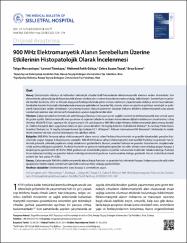| dc.contributor.author | Mercantepe, Tolga | |
| dc.contributor.author | Tümkaya, Levent | |
| dc.contributor.author | Gökçek, Mehmet Fatih | |
| dc.contributor.author | Suzan, Zehra Topal | |
| dc.contributor.author | Esmer, Erva | |
| dc.date.accessioned | 2020-12-19T20:42:49Z | |
| dc.date.available | 2020-12-19T20:42:49Z | |
| dc.date.issued | 2018 | |
| dc.identifier.citation | Mercantepe, T., Tümkaya, L., Gökçe, M.F., Topal, Z.S., Esmer, E. (2018). Effect of 900-MHz electromagnetic field on the cerebellum: a histopathological investigation. Şişli Etfal Hastanesi Tıp Bülteni, 52(2), 129-134. | |
| dc.identifier.issn | 1302-7123 | |
| dc.identifier.issn | 1308-5123 | |
| dc.identifier.uri | https://doi.org/10.14744/SEMB.2018.42275 | |
| dc.identifier.uri | https://app.trdizin.gov.tr/makale/TWpnMk1EUXhNUT09 | |
| dc.identifier.uri | https://hdl.handle.net/11436/5780 | |
| dc.description.abstract | Objectives: The currently widely used technological devices give rise to electromagnetic fields (EMFs) at various frequencies. Recent studies have reported that EMFs damage the central nervous system. The cerebellum is of considerable importance to human life due to its involvement in motor control, language, and cognitive-sensory functions. Damage occurring in the histological layers of the cerebellar cortex causes various neurological and psychiatric diseases, such as paralysis, tumor, autism, and schizophrenia. Our study involved a histopathological evaluation of the effects of communication systems’ standard 900-MHz EMF on the cerebellum. Methods: Sprague–Dawley rats were assigned into two groups containing six animals each: control and EMF. The EMF group was exposed to a 24-h 900-MHz radiofrequency EMF over 20 days with a digital modulation signal generator installed in the middle of their cage. Ten days after EMF application, the rats were sacrificed by cervical dislocation under anesthesia induced with 50 mg/kg ketamine hydrochloride and 10 mg/kg intraperitoneal xylazine HC1. Results: Intense caspase-3 expression was seen in the Purkinje cells and granular cells exposed to a 900-MHz frequency EMF (p<0.05). Pyknotic nuclei were notable in the Purkinje and granular cells exposed to a 900-MHz EMF. We also observed a decrease in the cytoplasm of the Purkinje and granular cells. Specimens from the EMF group exhibited decreases in the thickness of the molecular cell layer, Purkinje cell layer, and granular cell layer compared with those from the control group. However, the difference was not statistically significant (p>0.05). Conclusion: A 900-MHz EMF causes deleterious effects on the cerebellum by giving rise to apoptosis accompanied by caspase-3 expression in the Purkinje and granular cells in particular. | en_US |
| dc.language.iso | eng | en_US |
| dc.rights | info:eu-repo/semantics/openAccess | en_US |
| dc.subject | Androloji | en_US |
| dc.subject | Anestezi | en_US |
| dc.subject | Kalp ve Kalp Damar Sistemi | en_US |
| dc.subject | Klinik Nöroloji | en_US |
| dc.subject | Yoğun Bakım, Tıp | en_US |
| dc.subject | Acil Tıp | en_US |
| dc.subject | Endokrinoloji ve Metabolizma | en_US |
| dc.subject | Gastroenteroloji ve Hepatoloji | en_US |
| dc.subject | Hematoloji | en_US |
| dc.subject | Nörolojik Bilimler | en_US |
| dc.subject | Kadın Hastalıkları ve Doğum | en_US |
| dc.subject | Onkoloji | en_US |
| dc.subject | Göz Hastalıkları | en_US |
| dc.subject | Ortopedi | en_US |
| dc.subject | Kulak, Burun, Boğaz | en_US |
| dc.subject | Pediatri | en_US |
| dc.subject | Psikiyatri | en_US |
| dc.subject | Romatoloji | en_US |
| dc.subject | Cerrahi | en_US |
| dc.subject | Transplantasyon | en_US |
| dc.subject | Üroloji ve Nefroloji | en_US |
| dc.title | Effect of 900-MHz electromagnetic field on the cerebellum: a histopathological investigation | en_US |
| dc.type | article | en_US |
| dc.department | RTEÜ, Tıp Fakültesi, Temel Tıp Bilimleri Bölümü | en_US |
| dc.identifier.doi | 10.14744/SEMB.2018.42275 | |
| dc.identifier.volume | 52 | en_US |
| dc.identifier.issue | 2 | en_US |
| dc.identifier.startpage | 129 | en_US |
| dc.identifier.endpage | 134 | en_US |
| dc.snmz | oa | en_US |
| dc.relation.journal | Şişli Etfal Hastanesi Tıp Bülteni | en_US |
| dc.relation.publicationcategory | Makale - Uluslararası Hakemli Dergi - Kurum Öğretim Elemanı | en_US |


















